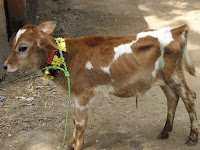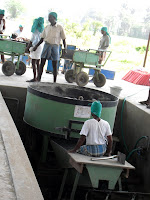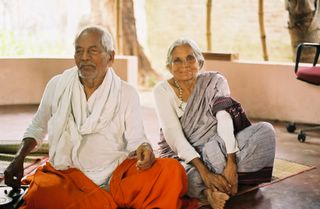
Vacation from my vacation is now over. It’s back to work again.
The day begins with Tipu having run off. We know why – he misses Amma. But we also know there is a dog-smuggling ring in the neighborhood (you can find everything in India if you look hard enough), and Tipu has been rescued from them in the nick of time once before. Finally, he is retrieved, and tied down in the house.
Krishnammal returned from her two days at Madurai and Gandhigram. Tipu is jumping for joy! First she attended the wedding. She says she never got to eat, as people kept coming up and prostrating themselves at her feet. No one actually expected she would show up. I asked whether she brought a wedding gift. She sniffed, and waved her hand in the air. But she did spend her time canvassing for contributions.
A third-grade boy (one of the thousand or so great-grand-nephews and nieces) ran up to her and proclaimed, “You are now in my history book!” Sure enough, Saint Run-Around is now in the required Tamil history books from the third through the ninth standards. Students may now have the opportunity to flunk a test for failing to recognize her name.
“Perhaps not such good news,” I suggest. “Almost all the other people in the history text are dead. And they are likely to “Helen Kellerize” you.”
I explain that to be “Helen Kellerized” is to have your life end at age 20, and all the things one stood for in life eliminated from public view. Find a children’s book about Helen Keller and you will never discover that she was an ardent socialist, an advocate of women’s rights, a pacifist who made strong statements condemning World War I at a time when it was unpopular to do so, and a ardent proponent of universal health care (which first became part of the public agenda during the administration of Teddy Roosevelt.) Since she was blind and deaf, authors have decided she was dumb as well.
“Yes, yes” she says, “It will say I came from a poor family and the scheduled castes, etc., etc., and I did good things and won many awards.” We agree that it will never say that she is a fighter against globalization and multinational corporations and the prawn farms, campaigned against temples and rich landlords and against corporate encroachment on the people’s land and livelihoods, against all forms of militarization, and is a proponent of self-reliance and Gandhi’s village republic.
Next she was off to Gandhigram Rural University, canvassing the various departments for contributions. She came back with a pledge for 5,000 bags of cement from the Vice Chancellor. As it turns out, Gandhigram has a housing program. They have received a lorry (we are jealous), jeeps, cement, and other building materials from the Central Government. They are all lying there unused. Krishnammal has invited them to our Independence Day (January 26th) and we will show them how the villagers can build their own houses.
Her “special” night train from Dindigul was three hours late, and didn’t leave until 2:30 a.m., with her waiting in the station attacked by the inevitable railway mosquitos. Arrived here at 11:00, and by 11:10 we were off to Chennai, with Veerasami, who traveled another eight hours by bus to get here.
After getting lost innumerable times, we finally found the offices of the M.S. Swaminathan Research Foundation, only two hours after we said we would be there. This is the appointment I have been trying to get for three months, and it is finally to happen.
M.S. Swaminathan made his fame (and fortune) by being the chief architect of India’s “Green Revolution”, which, through the introduction of “modern” agricultural methods, including the use of patented seeds which had to be repurchased each year and artificial fertilizers, massively increased agricultural yields in northern India. Because the inputs were so intensive, the program could only be carried out with large holdings, and more than 90 million people ended up being essentially forcibly removed from the land, many crowded into India’s major cities to live in absolute squalor. India did, however, become a significant exporter of agricultural produce, even as domestic malnutrition has soared in the past two decades. All agree (including Dr. Swaminathan) that the Green Revolution has been an utter failure in the south.
In recent years, Dr. Swaminathan has softened his views considerably, and now agrees that the sustainability must begin with more equitable distribution of land resources, and intense efforts at conservation and sustainability. Years ago, Jagannathanji visited this campus to make an unsuccessful appeal to Dr. Swaminathan to get him to condemn the new multinational-backed prawn farm initiatives that were destroying the land, only to be rebuffed. Ironically, Krishnammal and Dr. Swaminathan received the Padmashri (rather like the President’s Medal of Freedom) in the same year.
We are not to see Dr. Swaminathan, but the Executive Director, and are quickly ushered into his office. This time, Krishnammal is here for display, and Veerasami to answer any questions about land conditions. This is my show. They are building a new pavilion near the entrance, and we joke that if we get nothing, we can take a bag of cement.
I profusely thank the Director for seeing us, apologize for being late, give him a copy of The Color of Freedom. He knows why we are here, and we are both well-prepared. First, he says he is developing a breed of transgenic rice that can grow in saline conditions. I remain steadfastly pokerfaced – I happen to know (thanks to the wonders of the Web) that this is his personal area of research and expertise, and I am not about to engage in a debate about biogenetic crops. I have more important business. Yesterday, there were wonderful pictures in the newspaper of protesters dressed up as eggplants, denouncing the potential introduction of a bioengineered variety. (Sadly, I forgot to cut it out.)
He senses my discomfort, and notes that his rice is years from government approval. Sigh of relief. Next, he turns his computer screen towards us and shows a video I have already seen of former prawn farm land being used for fish farming in Andhra Pradesh, in a process developed by the Foundation. Not what I had in mind. We are not particularly interested in producing products for the market. We need rice land! He says that we should keep open minds about mixed uses, and I diplomatically agree that uses should be chosen based on environmental conditions, and we have grown mangroves close to shore (but the lands I am referring to are more than 500 yards from shore., and ALL the land we are talking about was former rice land.) Someone may make a nice fish farm in the estuaries – it just isn’t us!
Then, bingo! There is a form of algae that can be raised in a small pond on one corner of a field during the rainy season. It is then spread over the entire area, and when it dries, it will leach salt from the soil! (He believes that the cancer-causing chemicals have long been removed from the soil in the rains – in reality, it doesn’t matter, as people have to live here in any case, Love Canal or not. In the next season one can grow rice! I show my intense enthusiasm. Then he mentions that there is a particular kind of salad green which can be grown which is very popular in Europe. I don’t see that happening. And some of the land can be used to grow forage for animals. I can get into that.
We end with an agreement. He has a 12-person research team in Pompuhar, just south of LAFTI’s area, and he will direct some of the scientists to come look at the area in early February and take soil samples to see what can best be done. I can’t ask for anything more than that. If it happens, it is a start. I thank him profusely, say that if there is anything I can do in support from the U.S. to have him please contact me. And thanks again.
I have no idea whether this will actually happen. I have been working on this intermittently for five years to no good effect, so I don’t want to get my hopes up too high. But maybe the stars have realigned after the solar eclipse. We shall just have to find out.
Then more backing-and-forthing at the Secretariat. We get in during lunch hour, so there is no pass, but Veerasami shows the newspaper clipping of Krishnammal receiving the Ambedkar Award from the Chief Minister, and that is more than sufficient. Third-Floor Minister is in Delhi, but we take over his air-conditioned office and Krishnammal lies down for one of her 10-minute Gandhi naps. They actually should provide a bedroom for her at the Secretariat, as she is here so often, and she actually has camped for a day or two as necessary with Third-Floor Minister. Veerasami and I chase after Eighth-Floor Minister; he is nowhere to be found. But good news! We can see the personal assistant to Stalin, the soon-to-be Chief Minister! Now it is through the giant rabbit warren. Rooms with millions and millions of papers and files. It probably looks the same as it did during the British Administration. I take a photograph of an ancient Gestetner copy machine, still in use. But we are finally led into the office, everyone bows and is delighted to see Krishnammal (there was plenty of excitement on the elevator for just Veerasami, which is quite striking, dressed as he is in his rural wear, surrounded by western-dressed bureaucrats).
The exemption for the stamp tax duty on the land purchase is now with Third-Floor Minister, we are told. This is good news – he is a friend. AND, we have a meeting with Stalin before a wedding we are now to attend (meaning 6:30 a.m.). I think Krishnammal is going to ask him for an immediate 50,000 bags of cement.
And back to Chengelput. All plans are changed. For the next three days, I am going to weddings! I am to be the wedding beggar. I complain to Krishnammal that she is feeding me too well – no one will give to a fat beggar. But we are now a traveling road show. Saint Run-Around and the Fat Beggar.
We end the day with my writing six fundraising appeals for bags of cement. All in a day’s vacation.























